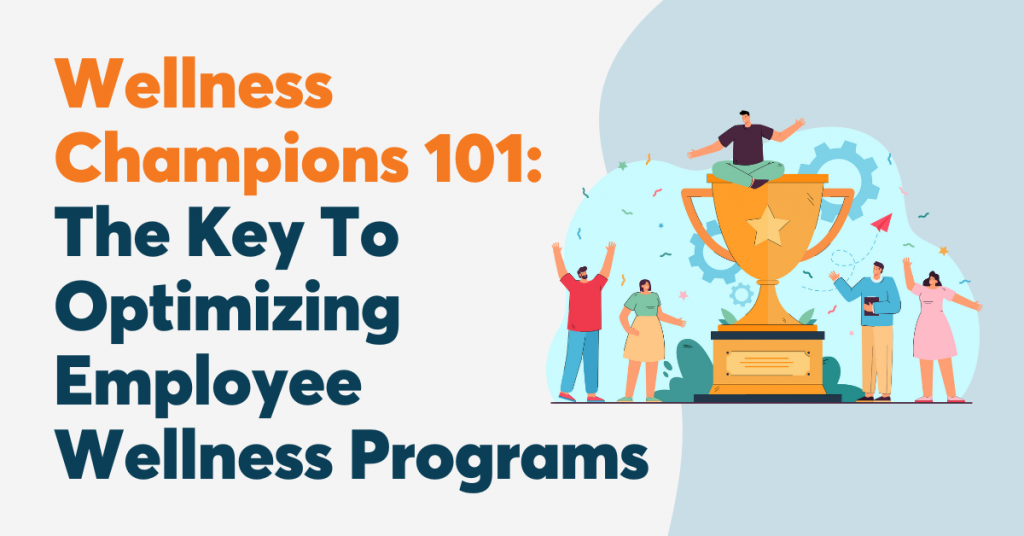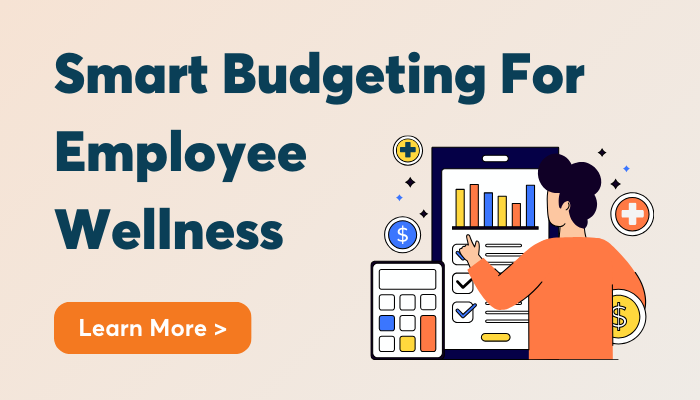Wellness programs have evolved from a nice-to-have perk to an essential component of a thriving workplace. Companies that prioritize employee well-being not only invest in their workforce but also drive higher productivity, reduce healthcare costs, and foster a culture of care. Starting a wellness program might seem daunting at first, but with a strategic approach and clear steps, it becomes a manageable, achievable, and rewarding endeavor.
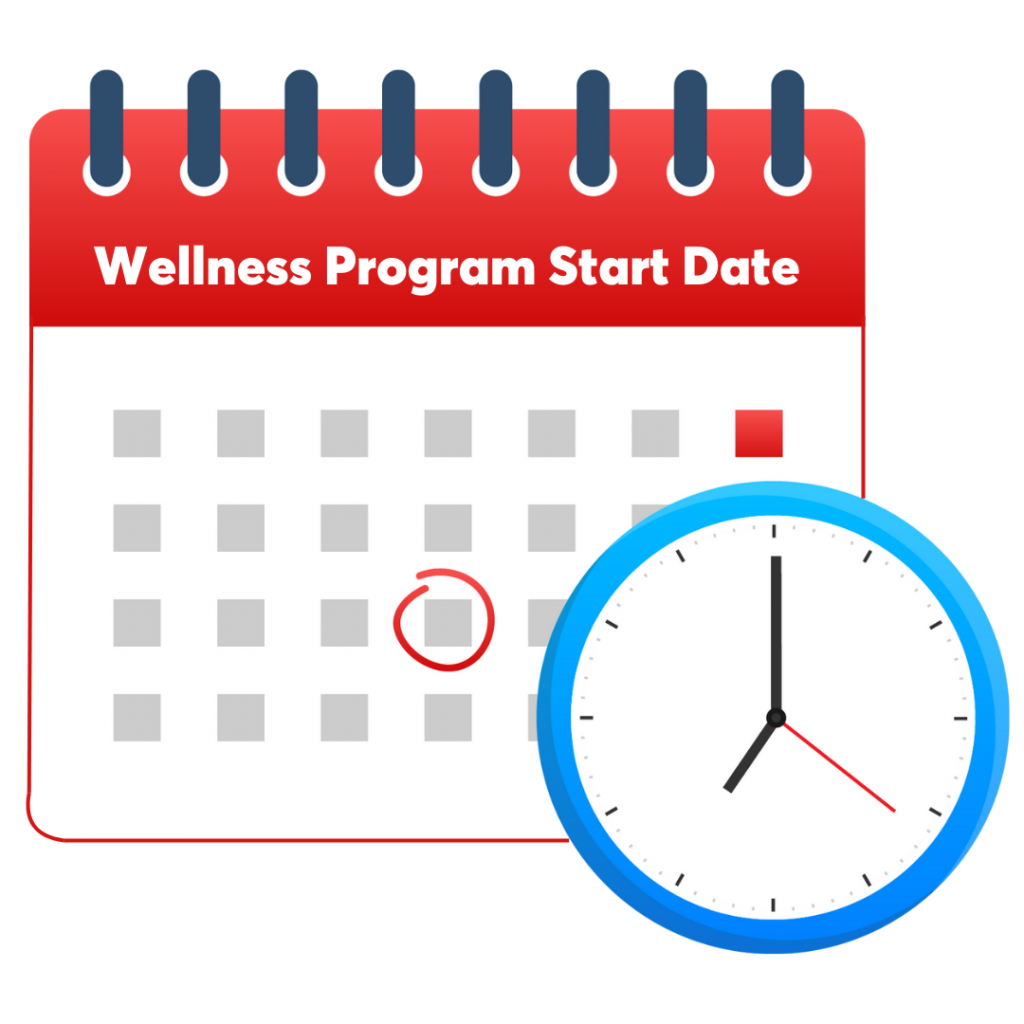
What Is A Corporate Wellness Program?
A corporate wellness program is a set of initiatives that promote healthy lifestyles among employees. These programs address various dimensions of well-being, such as physical fitness, mental health, financial well-being, and social wellness.

Benefits Of Wellness Programs For Employees
Wellness programs offer numerous benefits, including:
- Improved health: Access to fitness activities, preventive care, and health education helps employees maintain and improve their total well-being.
- Boosted morale: Launching a wellness program reflects a company’s commitment to employee wellness, increasing job satisfaction and motivation.
- Heightened productivity: Wellness programs equip employees with resources like nutrition guidance and stress management workshops. These tools help them confidently bring their best selves to work, leading to improved focus, energy, and overall performance.
- Enhanced loyalty: Wellness programs help employees feel valued by their employer, strengthening loyalty and reducing turnover rates.
- Increased resilience: Programs focused on mental health and stress management enhance employees’ ability to cope with challenges and adapt to change.
- Reduced absenteeism: Healthier employees are less likely to take sick days, leading to lower absenteeism and a more reliable workforce.
7 Steps To Starting A Wellness Program
Here’s how to start a corporate wellness program in your organization:
1. Secure Executive Buy-In
Getting senior management on board ensures the wellness program receives the resources necessary for long-term success, including budget, time, and support. To gain their buy-in, consider the following:
- Highlight the benefits of wellness programs, such as increased productivity, improved retention rates, and reduced absenteeism.
- Emphasize how a wellness program aligns with organizational goals and values, such as enhancing company image and cultivating a culture of health.
- Share success stories from similar organizations to illustrate positive outcomes.
- Prepare to address and mitigate potential concerns, such as the initial investment cost or the time required to see tangible benefits.
Additionally, discuss the return-on-investment (ROI) and value-on-investment (VOI) of wellness programs. Present data showing that for every dollar spent on wellness programs, companies often experience financial gains from savings in healthcare claims and costs. Highlight how VOI encompasses intangible benefits like improved employee morale, enhanced company reputation, and increased employee engagement. Together, these metrics help build a compelling case for the long-term benefits and sustainability of the wellness program to secure executive support.
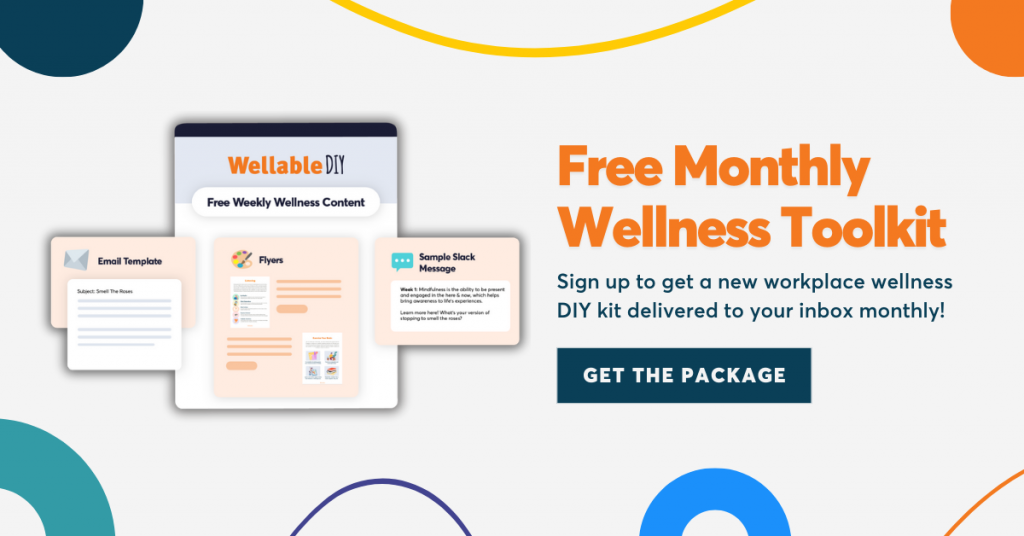
2. Form A Wellness Committee
A wellness committee collaborates to generate ideas, coordinate activities, and ensure that initiatives align with employee needs and organizational goals. The group should include members from various departments and levels to fully represent the entire organization. This variety of perspectives guides the creation of initiatives that benefit everyone. A well-rounded committee should include:
- Leaders who can provide strategic direction, ensure alignment with organizational goals, and demonstrate top-level support for the program
- HR representatives who understand employee needs, company policies, and legal considerations
- Wellness champions (voluntary employees who are passionate about health and wellness) from various departments who act as advocates and cheerleaders while encouraging participation and feedback
Assign specific roles to committee members, such as research, communication, event planning, and data analysis to promote accountability and ensure effective coordination. Don’t forget to schedule regular meetings to discuss progress, address challenges, and brainstorm new ideas.
3. Conduct A Needs Assessment
Creating an effective wellness program involves aligning it with employees’ needs, interests, and goals. By gathering insights from employee interest surveys and personal wellness assessments, you can pinpoint common themes that require attention. This also provides employees with an opportunity to voice opinions, questions, and concerns. Involving participants in the planning process ensures the program is relevant to everyone, increasing participation, maximizing engagement, and providing genuine value. Key areas to assess include:
- Areas in need of support: Determine specific dimensions of well-being that require significant support, such as physical fitness, mental health, or financial well-being.
- Preferred wellness activities: Understand which initiatives would garner high participation, such as fitness classes, meditation sessions, or nutrition workshops, ensuring that investments are worthwhile.
- Willingness and readiness to participate: Guage employees’ readiness to engage in initiatives based on their current stage in their wellness journey. Some may show reluctance due to time constraints or lack of awareness, which calls for smaller, more approachable initiatives, while others may be prepared for more comprehensive programs.

4. Confirm A Budget
To determine the financial resources available for the wellness program, consider direct and indirect costs. Direct costs may include expenses for:
- Program activities: Some initiatives may cost nothing beyond the time investment, like lunchtime walking groups. Others may require greater investment, like fitness classes, health coaching, and workshops.
- Incentives: Rewards for participation, such as gift cards or fitness gear, typically range from $10 to $100. However, free incentives like public recognition or extra work-from-home days can also effectively motivate employees.
- Technology or apps: Budget for wellness apps or platforms that track progress, provide on-demand classes, or offer health resources. Costs can vary widely, from free apps to subscription-based services costing $10 to $50 per employee annually.
Indirect costs may cover:
- Administrative time: Consider the time and effort that goes into planning, coordinating, and managing the wellness program.
- Training and education: Training for wellness program coordinators or providing educational materials for employees can incur additional costs.
- Communication and promotion efforts: Ensuring high participation rates may require ongoing efforts to promote the program and keep employees engaged, which can also consume time and resources.
Allocate funds to align with priorities identified in the needs assessment. For example, if high stress is a common issue among employees, dedicate a substantial portion of the funds to mental health resources (e.g., stress management workshops, meditation sessions, counseling). A smaller portion can be devoted to perks like participation incentives or healthy snacks in the office, which can still have a meaningful impact without extensive spending.
5. Set S.M.A.R.T. Goals
S.M.A.R.T. goals provide clear direction and accountability when starting a wellness program. These objectives should be:
- Specific: Define exactly what you want to accomplish (e.g., “Increase employee participation in nutrition workshops by 20% within six months”).
- Measurable: Establish metrics to track progress, measure success, and make data-driven adjustments. These could include participation rates, health outcomes, or employee satisfaction levels.
- Achievable: Ensure the goal is attainable given the existing constraints and resources available. For instance, if the goal is to increase health fair sign-ups, provide multiple session times so employees can choose what best fits their schedules.
- Relevant: Align the goal with organizational priorities and employee needs. If employees have expressed a strong interest in financial wellness, but current priorities pertain to fitness, consider revising the focus to better match workforce needs.
- Time-bound: Set a timeline for achieving the goal. Assigning deadlines to each objective ensures consistent progress.
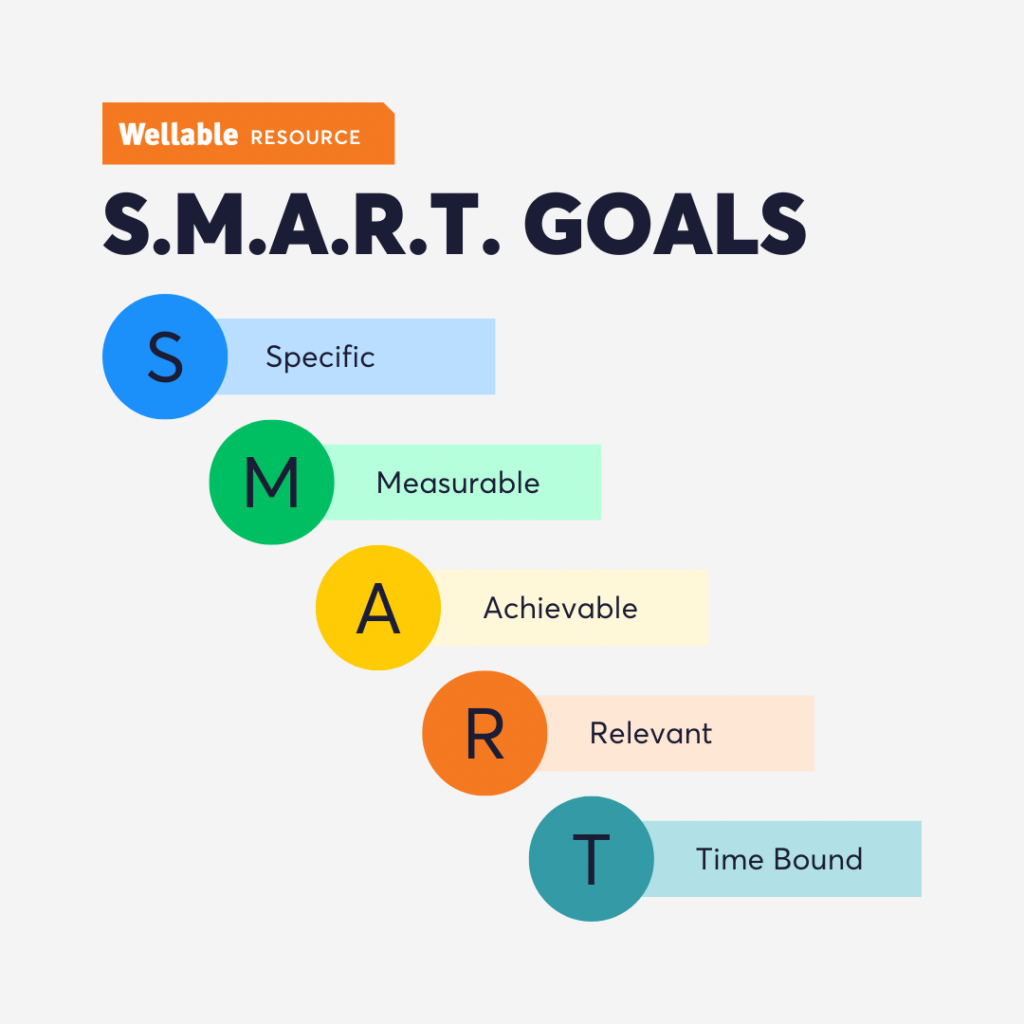
6. Create A Timeline For Rollout
A phased implementation promotes manageable growth and provides opportunities to gather and act on feedback. Start with activities that are easy to implement and likely to generate quick wins. For example, a step challenge is simple to participate in and can build enthusiasm before rolling out more complex initiatives.
Example Timeline:
- 3 Months Pre-Launch: Distribute employee interest surveys and define budget.
- 2 Months Pre-Launch: Plan reward options and establish leadership support and buy-in.
- 1 Month Pre-Launch: Promote the program through various campaign channels.
- Launch Month (Month 1) through Month 2: Introduce basic fitness and nutrition initiatives, such as weekly walk-and-talk meetings and morning stretching sessions.
- Month 3 through 6: Implement workshops, seminars, and other educational activities on more in-depth topics like stress management, mindfulness, or financial wellness with small rewards for participation.
- Month 7 through 8: Launch a comprehensive company-wide fitness challenge with more substantial incentives for participation.
This is just one example of how to structure a wellness program timeline. For personalized guidance and support in launching your own program, schedule a demo with Wellable.
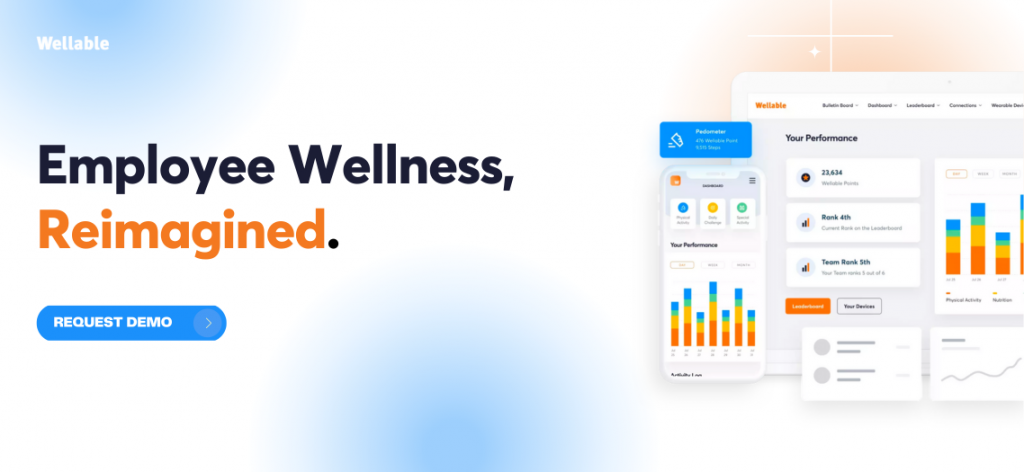
7. Promote & Communicate
Regular and meaningful communication keeps the wellness program top-of mind and ensures employees have the information necessary to participate. A well-planned communication strategy includes:
- Welcome sessions when starting a wellness program, outlining the benefits of participation and clear instructions on how to enroll, access resources, and participate in initiatives
- Regular reminders and updates through internal communication channels (email newsletters, Slack or Teams messages, bulletin boards, etc.)
- Wellness calendars to keep employees informed about upcoming activities and events, which can be shared through a wellness portal or monthly email
Each member of the wellness committee plays a unique role in the communication strategy:
- Leaders endorse the program, reinforcing its significance and credibility with top-level support
- HR representatives maintain the structure and flow of communication, ensuring that all employees receive timely updates and know how to access program resources
- Wellness champions share personal experiences and provide peer-to-peer encouragement, making the program relatable and accessible
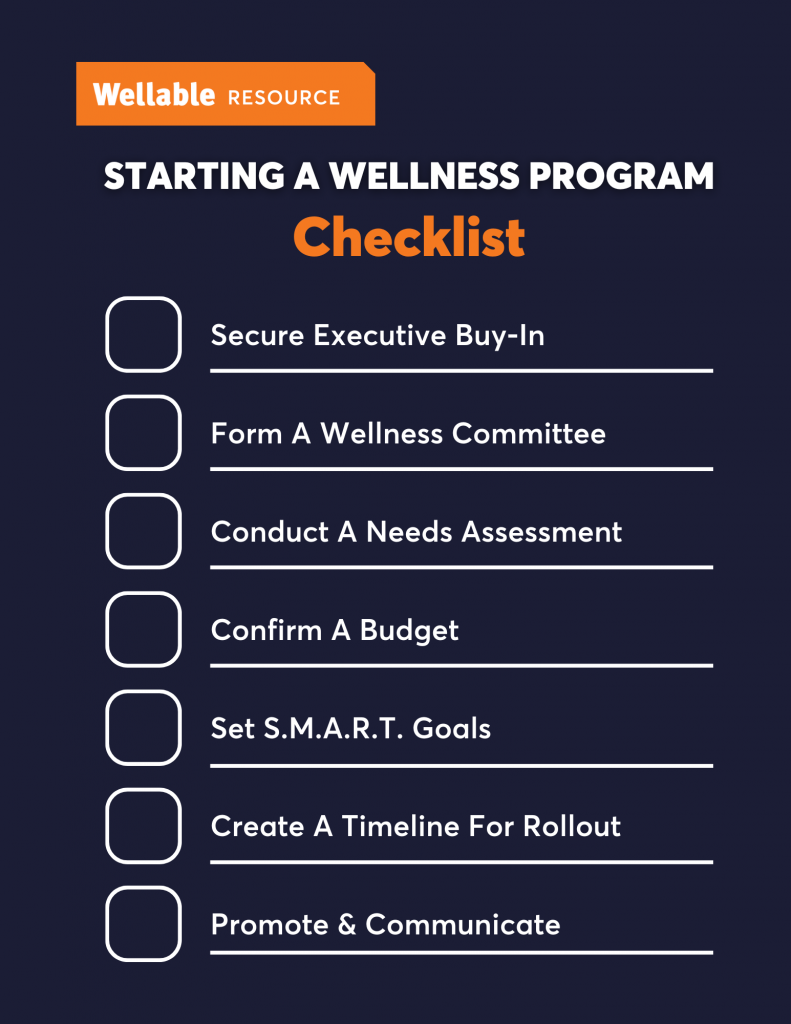
Conclusion
Starting a wellness program requires a cultural shift that engages all levels of the organization, including considering employee needs, forming a diverse wellness committee, and maintaining regular communication. Thoughtful resource allocation and clear goal setting ensures the program’s effectiveness and sustainability. By integrating these elements, you can create an impactful, comprehensive program for a healthier, happier, and more productive workforce.
Not ready fully ready to launch a wellness program? Use Wellable DIY, a free toolkit that simplifies the process. Just copy, paste, and distribute wellness resources for a no-risk, high-reward start.




